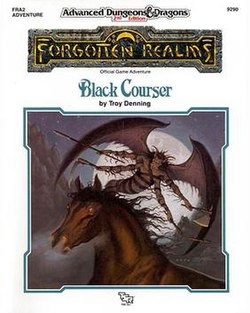 | |
| Code | FRA2 |
|---|---|
| Authors | Troy Denning |
| First published | 1990 |
Black Courser is an adventure module published in 1990 for the second edition of Advanced Dungeons & Dragons fantasy role-playing game.
 | |
| Code | FRA2 |
|---|---|
| Authors | Troy Denning |
| First published | 1990 |
Black Courser is an adventure module published in 1990 for the second edition of Advanced Dungeons & Dragons fantasy role-playing game.
Black Courser is an adventure in which the player characters search for a lost city to obtain an artifact to free the Purple Dragon so that the characters can overcome an evil raja. [1]
FRA2 Black Courser was written by Troy Denning, with a cover by Brom, and was published by TSR in 1990 as a 32-page book, an 8-page booklet, and an outer folder. [1]